数字图像处理与机器视觉 2015-2016期末试卷参考答案
《数字图像处理》习题参考答案
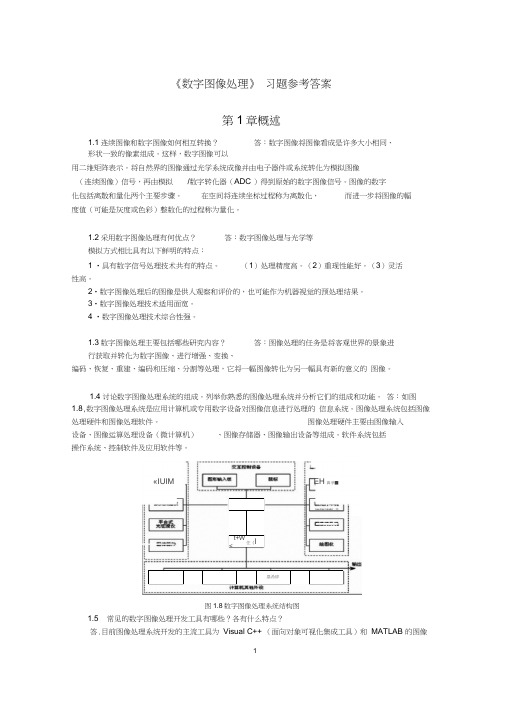
1《数字图像处理》 习题参考答案第1章概述1.1连续图像和数字图像如何相互转换?答:数字图像将图像看成是许多大小相同、形状一致的像素组成。
这样,数字图像可以用二维矩阵表示。
将自然界的图像通过光学系统成像并由电子器件或系统转化为模拟图像 (连续图像)信号,再由模拟 /数字转化器(ADC )得到原始的数字图像信号。
图像的数字化包括离散和量化两个主要步骤。
在空间将连续坐标过程称为离散化,而进一步将图像的幅度值(可能是灰度或色彩)整数化的过程称为量化。
1.2采用数字图像处理有何优点?答:数字图像处理与光学等模拟方式相比具有以下鲜明的特点:1 •具有数字信号处理技术共有的特点。
(1)处理精度高。
(2)重现性能好。
(3)灵活性高。
2•数字图像处理后的图像是供人观察和评价的,也可能作为机器视觉的预处理结果。
3•数字图像处理技术适用面宽。
4 •数字图像处理技术综合性强。
1.3数字图像处理主要包括哪些研究内容?答:图像处理的任务是将客观世界的景象进行获取并转化为数字图像、进行增强、变换、编码、恢复、重建、编码和压缩、分割等处理,它将一幅图像转化为另一幅具有新的意义的 图像。
1.4讨论数字图像处理系统的组成。
列举你熟悉的图像处理系统并分析它们的组成和功能。
答:如图1.8,数字图像处理系统是应用计算机或专用数字设备对图像信息进行处理的 信息系统。
图像处理系统包括图像处理硬件和图像处理软件。
图像处理硬件主要由图像输入设备、图像运算处理设备(微计算机) 、图像存储器、图像输出设备等组成。
软件系统包括操作系统、控制软件及应用软件等。
1.5 常见的数字图像处理开发工具有哪些?各有什么特点?答.目前图像处理系统开发的主流工具为 Visual C++ (面向对象可视化集成工具)和 MATLAB 的图像t+W<住《l 塁希碎«IUIMEH 鼻爭■图1.8数字图像处理系统结构图处理工具箱(Image Processing Tool box )。
(完整word版)数字图像处理期末考试试题 (2)
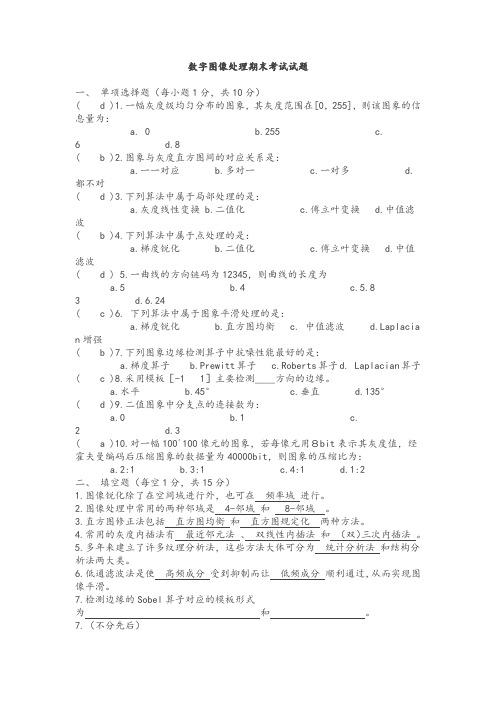
1
2
3
2
1
2
4
2
3
1
2
3
1
2
0
1
解:1)统计图象1各灰度级出现的频率结果为
p(0)=5/64»0.078;p(1)=12/64»0.188;p(2)=16/64=0.25;p(3)=9/64»0.141
p(4)=1/64»0.016; P(5)=7/64»0.109;p(6)=10/64»0.156;p(7)=4/64»0.063
对上式作逆傅立叶变换得逆滤波恢复图象f(x,y)
f(x,y)=IDFT[F(u,v)]
以上就是逆滤波恢复图象的原理。(2分)
若存在噪声,为避免H(u,v)=0,可采用两种方法处理。(0.5分)
2H(u,v)=0时,人为设置1/H(u,v)的值;
②使1/H(u,v)具有低同性质。即
H-1(u,v)=1/H(u,v)当D≤D0
a.灰度线性变换 b.二值化c.傅立叶变换d.中值滤波
(b )4.下列算法中属于点处理的是:
a.梯度锐化b.二值化c.傅立叶变换d.中值滤波
(d ) 5.一曲线的方向链码为12345,则曲线的长度为
a.5b.4c.5.83d.6.24
(c )6. 下列算法中属于图象平滑处理的是:
a.梯度锐化b.直方图均衡c. 中值滤波placian增强
(√) 4. 共点直线群的Hough变换是一条正弦曲线。
(√) 5. 边缘检测是将边缘像元标识出来的一种图像分割技术。
五、简答题(每小题5分,共20分)
1.简述线性位移不变系统逆滤波恢复图像原理。
答:设退化图象为g(x,g),其傅立叶变换为G(u,v),若已知逆滤波器为1/H(u,v)则对G(u,v)作逆滤波得F(u,v)=G(u,v)/H(u,v)(2分)
数字图像处理试题答卷及参考答案2015年
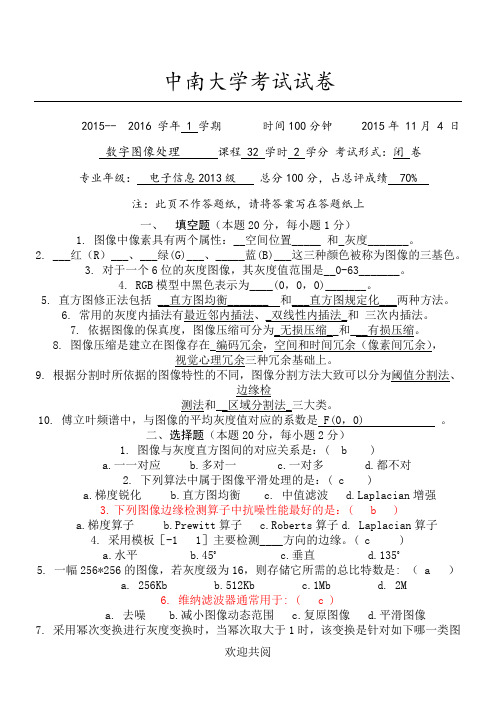
中南大学考试试卷2015-- 2016 学年 1 学期时间100分钟 2015年 11月 4 日数字图像处理课程 32 学时 2 学分考试形式:闭卷专业年级:电子信息2013级总分100分,占总评成绩 70%2.___5.8.9.10.a.梯度算子b.Prewitt算子c.Roberts算子d. Laplacian算子4.采用模板[-1 1]主要检测____方向的边缘。
( c )a.水平b.450c.垂直d.13505.一幅256*256的图像,若灰度级为16,则存储它所需的总比特数是:( a )a. 256Kbb.512Kbc.1Mbd. 2M6.维纳滤波器通常用于: ( c )a. 去噪b.减小图像动态范围c.复原图像d.平滑图像7.采用幂次变换进行灰度变换时,当幂次取大于1时,该变换是针对如下哪一类图像进行增强。
( b)a. 图像整体偏暗b. 图像整体偏亮c. 图像细节淹没在暗背景中d.图像同时存在过亮和过暗背景8.对于任意两点p(x,y) 和q(s,t)之间的D8距离,以下说法错误的是:( a )a. D8 (p,q)=|x-s|+|y-t|b. D8(p,q)=max(|x-s|,|y-t|)c. D8=1的像素就是(x,y)的8-邻域像素d. D8距离别名棋盘距离。
9.傅立叶变换得到的频谱中,低频系数对应于:( c )10.’)。
2.’)2’)(2’)都属于图像增强,改善图像效果。
(2’)4.试画出图像退化模型框图,并写出退化模型的解析式f(x,y)表示理想的、没有退化的图像,g(x,y)是退化(所观察到)的图像,η(x,y)表+示加性噪声,H是退化函数,则:g(x,y)= H[f(x,y)]+ η(x,y) (2’)5.画出变换编码的流程框图,说明其中正交变换的作用正交变换的作用是将图像的能量尽量集中在少数系数上,从而最大限度地去除原始图像中数据间的相关。
(2')(考察图像压缩)四、利用3x3窗口对下图进行均值滤波与中值滤波(均值滤波请4舍5入取整数),并说明两种滤波方法的不同适合情况。
数字图像处理试卷参考答案
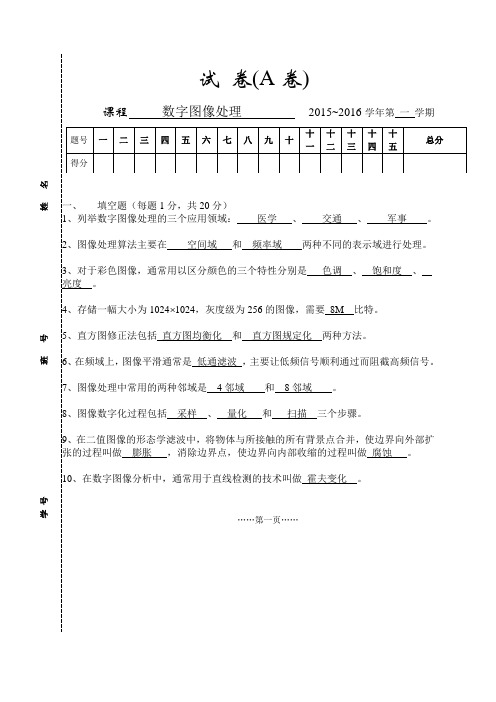
二、名词解释(每题2分,共10分)1、灰度直方图直方图是灰度级的函数,它表示图像中具体每种灰度级的像素个数,反映图像中每种灰度出现的概率。
2、图像增强对图像的某些特征,如边缘、轮廓、对比度等进行强调或尖锐化,以便观察或进一步分析处理。
3、中值滤波对于一个滑动窗口内N⨯M个像素按灰度级排序,用处于中间位置的像素的灰度级来代替窗口中心像素原来的灰度级。
4、图像边缘边缘是指图像中灰度发生急剧变化的区域。
5、阈值阈值是在分割时作为区分物体和背景像素的门限,大于或等于阈值的像素属于物体,而其他属于背景。
二、简答题(共70分)1、请简述两种常见的图像平滑方法及其特点。
(10)均值滤波:对于一个滑动窗口内N⨯M个像素按灰度级求平均值,用处于中间位置的像素的灰度级来代替窗口中心像素原来的灰度级。
特点:系数之和为1,系数都是正数,容易造成图像模糊。
对于一个滑动窗口内N⨯M个像素按灰度级排序,用处于中间位置的像素的灰度级来代替窗口中心像素原来的灰度级。
特点:计算复杂度高,滤波前后图像亮度发生改变,不容易产生模糊,具有良好的抗噪性能。
2、若使用下列模板分别对一幅灰度图像进行卷积,会达到什么样的效果?(10)(1) 均值滤波,图像变模糊 (2) 边缘检测 (3) 无意义 (4) 边缘锐化3、对下面的图像进行8链码(0-7)的轮廓跟踪,写出跟踪得到的链码序列,并计算链码:(1,1)76660000773332224444 周长:1426+⨯ 面积:13(2,2)1076654322面积:104、有一幅电视图像如下,在接收时图像有若干个亮点(灰度为255),设计两种滤波方法对该图像滤波,写出滤波后的图像。
(10)1 1 1 8 7 42 255 255 255 255 33 34 4 3 33 3 255 255 255 63 345 5 8均值滤波1 1 1 8 7 42 58 87 88 60 33 87 143 171 115 33 31 60 88 60 63 31 60 88 62 82 3 4 6 7 8中值滤波1 1 1 8 7 42 3 4 7 4 33 3 255 255 6 33 345 5 63 34 6 7 82 3 4 6 7 85、假定你有两张相隔八个月拍摄的一病人的胸部X光片。
图像处理期末考卷(答案)
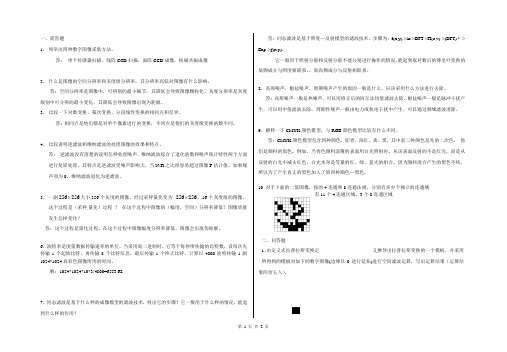
一、简答题1、 列举出四种数字图像采集方法。
答: 单个传感器扫描,线阵CCD 扫描,面阵CCD 成像,核磁共振成像2、 什么是图像的空间分辨率和灰度级分辨率,其分辨率高低对图像有什么影响。
答:空间分辨率是图像中,可辨别的最小细节,其降低会导致图像颗粒化。
灰度分辨率是灰度级别中可分辨的最小变化,其降低会导致图像出现为轮廓。
3、 比较一下对数变换、幂次变换、分段线性变换的相同点和差异。
答: 相同点是他们都是对单个像素进行的变换,不同点是他们的灰度级变换函数不同。
4、 比较说明逆滤波和维纳滤波的处理图像的效果和特点。
答: 逆滤波没有清楚的说明怎样处理噪声,维纳滤波综合了退化函数和噪声统计特性两个方面进行复原处理。
其特点是逆滤波受噪声影响大,当N/H 之比很容易超过图像F 估计值。
如果噪声项为0,维纳滤波退化为逆滤波。
5、 一副256256⨯大小,256个灰度的图像,经过采样量化变为 256256⨯,16个灰度级的图像,这个过程是(采样,量化)过程 ? 在这个过程中图像的(幅度,空间)分辨率降低?图像质量发生怎样变化?答:这个过程是量化过程。
在这个过程中图像幅度分辨率降低,图像会出现伪轮廓。
6、波特率是度量数据传输速率的单位,当采用而二进制时,它等于每秒所传输的比特数,设每次先传输1个起始比特,再传输8个比特信息,最后传输1个终止比特,计算以4800波特传输1副1024*1024真彩色图像所用的时间。
解:1024*1024*10*3/4800=6553.6S7、同态滤波是基于什么样的成像模型的滤波技术,列出它的步骤?它一般用于什么样的情况,能起到什么样的作用?答:同态滤波是基于照度—反射模型的滤波技术。
步骤为:f(x,y)->ln->DFT->H(u,v)->(DFT)-1 -> Exp->g(x,y)。
它一般用于照射分量和反射分量不能分别进行操作的情况。
能起到取对数后的傅里叶变换的低频成分与照度相联系,。
数字图像处理试题和答案解析
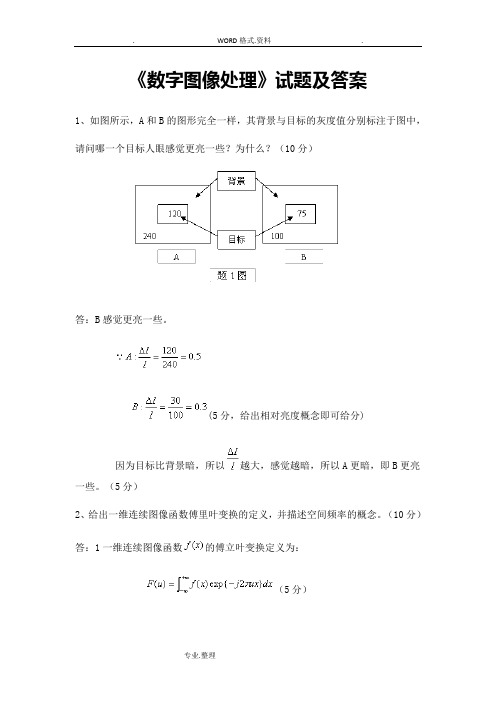
《数字图像处理》试题及答案1、如图所示,A和B的图形完全一样,其背景与目标的灰度值分别标注于图中,请问哪一个目标人眼感觉更亮一些?为什么?(10分)答:B感觉更亮一些。
(5分,给出相对亮度概念即可给分)因为目标比背景暗,所以越大,感觉越暗,所以A更暗,即B更亮一些。
(5分)2、给出一维连续图像函数傅里叶变换的定义,并描述空间频率的概念。
(10分)答:1一维连续图像函数的傅立叶变换定义为:(5分)2空间频率是指单位长度内亮度作周期变化的次数。
(2分)对于傅立叶变换基函数,考虑的最大值直线在坐标轴上的截距为,则表示空间周期,即为空间频率。
(3分)3、已知的图像数据如图所示,请计算:(15分)a、的离散傅里叶变换;b、的哈德玛变换。
题3图答:1令,则,(5分)2(3分)则哈德玛变换为(3分)4、写出频域拉普拉斯算子的传递函数,并说明掩模矩阵对图像的卷积与拉普拉斯算子对图像运算结果之间的关系。
(15分)答:1F =F=F=F +F(6分)2相当于原图像与拉普拉斯算子运算之差(3分)。
因为拉式算子:(2分)所以:=-(4分)5、如图为一幅16级灰度的图像。
请写出均值滤波和中值滤波的3x3滤波器;说明这两种滤波器各自的特点;并写出两种滤波器对下图的滤波结果(只处理灰色区域,不处理边界)。
(15分)题5图答:均值滤波:(2分)中值滤波:(2分)均值滤波可以去除突然变化的点噪声,从而滤除一定的噪声,但其代价是图像有一定程度的模糊;中值滤波容易去除孤立的点、线噪声,同时保持图像的边缘。
(5分)均值滤波:(3分)中值滤波:(3分)6、写出图像退化/复原的总体模型;利用线性系统的相关知识,推导线性空不变条件下连续图像函数的退化模型。
(10分)答:(5分)线性系统中:其中为系统H的冲激响应。
又空不变系统,则(5分)7、如图,X是待处理图像,黑点代表目标,白点代表背景;B是结构元素,原点在中心。
试分别给出B对X做开运算和闭运算的结果(在图中涂黑目标点即可)。
2015-数字图像处理试题+答案

西安电子科技大学考试时间 120 分钟试题答案及评分标准1.考试形式:闭卷□ 开卷□ ;2.本试卷共二大题,满分100分;3.考试日期: 年 月 日;(答题内容请写在装订线外)1分,共15分)图像的保真度准则主要有 客观 保真度准则和 主观 保真度准则。
下图1是一幅标准测试图像Lena 图,对图像进行处理后,形成的结果图像如图2所示。
这是如何处理得到的 边缘检测 ?图像编码是通过改变图像的描述方式,将数据中的 冗余 去除,由此达到压缩数据量的目的。
低通滤波法是使 高频 受到抑制而让 低频 顺利通过,从而实现图像平滑。
每种不同的压缩编码方法都有其不同的特点。
将若干种编码方法结合在一起,由此来达到更高的压缩率,这种编码方式称为 混合编码 。
形态学处理中最基本的运算是腐蚀与膨胀。
其中 膨胀 通常用以填补目标物中存在的某些空洞。
关于图像的矩描述子,下列说法正确的是 C 。
a) 仅具有平移不变性 b)仅具有平移和尺度变换不变性c) 具有平移、旋转和尺度变换不变性d) 不具备不变性。
8.列举数字图像处理的三个应用领域汽车牌照识别、医疗、航空航天等。
9.存储一幅大小为1024*1024,256个灰度级的图像,需要8M 字节。
10.直方图均衡化适用于增强直方图呈不均匀分布的图像。
11.以下分割方法中属于区域算法的是分裂合并、阈值分割。
a). 分裂合并b). 哈夫变换c). 边缘检测d). 阈值分割12.一幅二值图像的傅里叶变换频谱是 B 。
a). 一幅二值图像b). 一幅灰度图像c). 一幅复数图像d). 一幅彩色图像13.伪彩色处理和假彩色处理是两种不同的色彩增强处理方法,说出下面属于伪彩色增强的处理 C 。
a).将景象中的蓝天边为红色,绿草变为蓝色b).用自然色复制多光谱的景象c).将灰度图经频域高通/低通后的信号分别送入红/蓝颜色显示控制通道d).将红、绿、蓝彩色信号分别送入蓝、红、绿颜色显示控制通道二、计算题(共85分)1. (10分)图像几何校正中,若f(1,1)=1, f(1,2)=5, f(2,1)=3, f(2,2)=4,请分别按最近邻插值法和双线型插值法确定(1.2,1.6)处的灰度值。
【数字图像处理】期末复习资料及期末模拟试卷(含答案)doc(DOC)
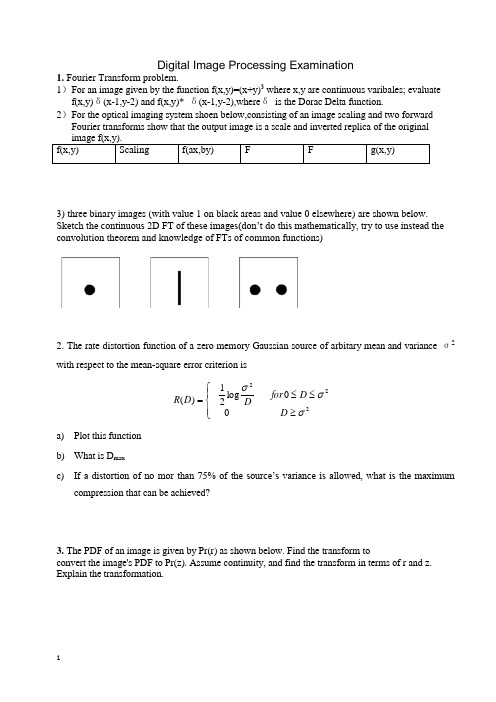
Digital Image Processing Examination1. Fourier Transform problem.1) F or an image given by the function f(x,y)=(x+y)3 where x,y are continuous varibales; evaluatef(x,y)δ(x-1,y-2) and f(x,y)* δ(x-1,y-2),where δ is the Dorac Delta function.2) F or the optical imaging system shoen below,consisting of an image scaling and two forwardFourier transforms show that the output image is a scale and inverted replica of the original3) three binary images (with value 1 on black areas and value 0 elsewhere) are shown below. Sketch the continuous 2D FT of these images(don’t do this mathematically, try to use instead the convolution theorem and knowledge of FTs of common functions)2. The rate distortion function of a zero memory Gaussian source of arbitary mean and variance σ2 with respect to the mean-square error criterion is⎪⎩⎪⎨⎧≥≤≤=2220log 21)(σσσD D for D D Ra) Plot this functionb) What is D max c) If a distortion of no mor than 75% of the source’s variance is allowed, what is the maximumcompression that can be achieved?3. The PDF of an image is given by Pr(r) as shown below. Find the transform toconvert the image's PDF to Pr(z). Assume continuity, and find the transform in terms of r and z. Explain the transformation.4. A certain inspection application gathers black & white images of parts as they travel along a con-veyor belt. It is necessary to sort the parts into two categories: parts with holes and parts with-out holes. An example of an image that might be taken by the inspection camera is shown at the right. Propose a method to identify and locate the objects of each category in the image so that they can be picked up by a robotic system and placed in different bins. Assume that the imaging system knows where each image pixel is located on the conveyor belt at every point in time.Provide an annotated flow chart of the algorithm you propose.5.In a given application, an averaging mask is applied to input images to reduce noise and then aLaplacian mask is applied to enhance small details. Would mathematics predict that the result should be the same if the order of the operations were reversed? What practical issues would be encountered in computer implementation?Digital Image Processing Examination1. A preprocessing step in an application of microscopy is concerned with the issue ofisolating individual round particles from similar particles that overlap in groups of two or more.Assuming that all particles are of the same size, propose a morphological algorithm that will produce an image that contains only the isolated (non-overlapping) particles that are not in contact with the boundary of the image.2. An image represented by a continuous function f(x, y) is w = 2 cm wide and h = 3 cm high. The imageis to be converted to an array of pixels by a scanner whose response is zero above 80 lines/centimeter in both the horizontal and vertical directions. The discrete image is represented by an array ˆf(n, m) where n and m take on integer values, 0 ~ n ~ N - 1, 0~ m ~ M-1.(a)Determine suitable values for N and M.(b)Assume that ˆf(n, m) = f(na, mb). Determine the values of a and b.(c)Determine constants A, B, C, D, E such that the DFT of fˆ can be expressed as)(00) ,() , (EvmDuniBnCmemnfAvu F+-==∑∑=(d)Find numbers (P1, P2) such that F(u + jP1, v + kP2) = F(u, v) for any integers j, k, u, v.3. The arithmetic decoding process is the reverse of the encoding procedure. Decode the message 0.23355 given the coding model.4. The gradient of a function f (x) is defined as⎥⎥⎥⎥⎦⎤⎢⎢⎢⎢⎣⎡∂∂∂∂=⎥⎥⎥⎦⎤⎢⎢⎢⎣⎡=∇y f x f G G f y xComputationally, the first derivative is implemented by calculating the difference between adjacent pixels.(a) Is the following a linear operator?2122⎥⎥⎦⎤⎢⎢⎣⎡⎪⎪⎭⎫ ⎝⎛∂∂+⎪⎭⎫ ⎝⎛∂∂=∇y f x f f (b) State how would you implement the above operator using differences between pixels.(c) A Sobel operator uses two masks, Hx and Hy to process an image. Explain why are two masksneeded and what do they measure?(d)Write down the masks Hx and Hy, and identify them in the followingfigures:5. The three images shown were blurred using square averaging masks of sizes n=23, 25 , and 45, respectively. The vertical bars on the left lower part of (a) and (c) are blurred, but a clear separation exists between them. However, the bars have merged in image (b), in spite of the fact that the mask that produced this image is significantly smaller than the mask that produced image (c). explain this.Digital Image Processing Examination1. An image array f(m, n) of size M1 × N1 is to be convolved with a filter array h(m, n) of size M2 × N2 to produce a new image array g(m, n).1)Write a pseudo code program that describes a method to compute g(m, n) throughthe use of Fourier transforms. The result should be the same size as would beachieved with direct convolution.2)Modify the algorithm so that it does the correlation f ~ h rather than theconvolution.2. You have the job of designing an algorithm that will count the number of objects with holes and the number of objects without holes in images of the kind shown here. Assume that the images are binary with 0 corresponding to black and 1 correspondingto white. The imaging system is of low quality and produces images that are corrupted with salt and pepper noise.The objects do not overlap or touch, but may be close to each other in any direction.They may be of any shape or size. The algorithm should not be confused by the salt and pepper noise, and should not count noise pixels as objects.Write a pseudo-code description of your algorithm. You may also include a block diagram and other information to make it understandable to a programmer. State any assumptions you make, such as: “Objects must contain at least 50 pixels.”least 50 pixels.”3. Suppose that an image has the gray-level probability density functions shown. Here, p 1(z) corresponds to objects and p 2(z) corresponds to the background. Assume that p 1=p 2 and find the optimal threshold between object and back ground pixels.4. The Sobel operator computes the following quantity at each location (x, y) in an image array, A:Gx[j,k]=(A[j+1,k+1]+2A[j+1,k]+A[j+1,k-1])-(A[j-1,k+1]+2A[j-1,k]+A[j-1,k-1]) Gy[j,k]=(A[j-1,k-1]+2A[j,k-1]+A[j+1,k-1])-(A[j-1,k+1]+2A[j,k+1]+A[j+1,k+1]) G[j,k] = |Gx[j,k]| + |Gy[j,k]|The position of A[j, k] is column j and row k of the array.The operation is implemented as the convolution of the image array A with two masks, Mx and My followed by the magnitude operation.1) Write a 3 × 3 array for each mask, Mx and My.2) What mathematical operation on an image array is approximated by the Sobeloperator? Show how the Sobel operator is related to the mathematical operation.5. Answer the following questions about morphological image processing.(a) Shown below are two tables with expressions that relate to binary morphological image processing. Associate each expression in the left table with one from the right table.(b) A well-known morphological algorithm uses the following iteration with a structuring element B.(1) Initialize X[p] = 1 for some pixel A p ∈(2) A B X Y )(⊕=(3) If X Y ≠ then set X = Y and repeat (2)An original set A is shown in (A) and an initial pixel p 2 A is shown in (B). The result after one iteration of the algorithm with structuring element⎥⎥⎥⎦⎤⎢⎢⎢⎣⎡=010111010Bis shown in (C). Fill in the result of the next two iterations by marking theappropriate pixels for the set Y in (D) and (E). In frame (F) show the result for Y that would be reached after a large number of iterations.Digital Image Processing Examination1. Consider the edge model depicted below. Sketch the gradient and Laplacian of the signal. It is not needed to compute exact numerical values in your answer. Plot of approximate shapes of the responses will be sufficient.2. The white bars in the test pattern shown are 7pixels wide and 210 pixels high. The separation between bars is 17 pixels. What would this image look like after application of .1) A 3*3 arithmetic mean filter?2) A 7*7 median filter.3) A 9*9 contraharmonic mean filter with Q=13. The video coding system introduced in the class utilizes several major components –inter-frame motion estimation, motion compensated prediction, DCT, Huffman coding,and quantization.(a)When an encoded signal can be used to reconstruct the exact value of theoriginal signal, we say the encoding method is lossless; otherwise, it’s calledlossy. A lossy coding technique introduces distortion to the signal.Which component in the above video coding system is lossy?(b)The motion compensation process in the encoder generates a motion vectorand prediction errors for each image block in the video signal. Suppose duringthe transmission of the encoded video stream, one motion vector is lost (e.g.,due to the network erasure error). What will be the visual effects of suchtransmission errors on the decoded image sequence?4.Consider a black-and-white image consisting of round and rectangular objects, as shown in the image below. Assume the sizes of the objects are fixed and known. We also know that the width and length of the rectangles are larger than the diameter of the circles. None of the rectangles are tilted. In general, the objects may overlap with each other.Design a morphological operation based system to automatically detect all the instances of the rounds objects that overlap with rectangular objects.5. An image A, represented by an N × M array of bytes, has a uniform brightnesshistogram. It is desired transform A into an image B in a way that produces a triangular brightness histogram2550,36240][≤≤=k k MNk h bDescribe a process that will accomplish the transformation. If possible, derive an equation for the transformation function. At a minimum, sketch the transformation function and indicate how you would use it in a program to compute the array B.模拟试卷一1.对将一个像素宽度的8通路转换到4通路提出一种算法。
数字图像处理试题及答案

数字图像处理试题及答案一、选择题1. 数字图像处理是指对图像进行数字化表示,并在计算机中进行处理和分析。
下面哪个选项是数字图像处理的主要目标?A. 提高图像的分辨率B. 压缩图像的存储空间C. 增强图像的质量D. 以上都是答案:D. 以上都是2. 在数字图像处理中,下面哪种滤波器用于平滑图像并降低图像中噪声的影响?A. 锐化滤波器B. 高通滤波器C. 低通滤波器D. 带通滤波器答案:C. 低通滤波器3. 在数字图像处理中,下面哪个选项描述了图像的亮度?A. 图像的红色通道值B. 图像的绿色通道值C. 图像的蓝色通道值D. 图像的灰度值答案:D. 图像的灰度值4. 数字图像处理中的阈值处理常用于图像分割,下面哪个选项描述了图像分割的目标?A. 将图像分成相似的区域B. 将图像转化为黑白二值图像C. 将图像进行几何变换D. 将图像进行色彩的增强答案:B. 将图像转化为黑白二值图像5. 数字图像处理中的直方图均衡化是一种用于增强图像对比度的方法。
下面哪个选项描述了直方图均衡化的基本原理?A. 将像素值映射到一个更大的范围B. 将像素值映射到一个更小的范围C. 根据像素值的概率分布进行映射D. 根据像素值的灰度级别进行映射答案:C. 根据像素值的概率分布进行映射二、简答题1. 请简要描述数字图像处理中的图像平滑技术,并举例说明。
答:图像平滑技术是一种降低图像中噪声和细节的方法。
常用的图像平滑技术包括均值滤波、中值滤波和高斯滤波等。
以均值滤波为例,该方法通过取邻域像素的平均值来平滑图像。
具体而言,对于每个像素点,将其周围的像素灰度值取平均后作为新的像素值。
这样可以减小图像中的噪声,并使图像变得更加平滑。
例如,对于一张包含椒盐噪声的图像,使用均值滤波可以去除部分噪声,提高图像的观看效果。
2. 请简要说明数字图像处理中的图像增强技术,并举例说明。
答:图像增强技术是一种通过调整图像的亮度、对比度和色彩等参数来改善图像质量的方法。
数字图像处理试题及参考答案

一、填空题(每题1分,共15分)1、列举数字图像处理的三个应用领域 医学 、天文学 、 军事2、存储一幅大小为10241024⨯,256个灰度级的图像,需要 8M bit 。
3、亮度鉴别实验表明,韦伯比越大,则亮度鉴别能力越 差 。
4、直方图均衡化适用于增强直方图呈 尖峰 分布的图像。
5、依据图像的保真度,图像压缩可分为 无损压缩 和 有损压缩6、图像压缩是建立在图像存在 编码冗余 、 像素间冗余 、 心理视觉冗余 三种冗余基础上。
7、对于彩色图像,通常用以区别颜色的特性是 色调 、 饱和度 亮度 。
8、对于拉普拉斯算子运算过程中图像出现负值的情况,写出一种标定方法:m i n m a x m i ((,))*255/()g x y g g g -- 二、选择题(每题2分,共20分) 1、采用幂次变换进行灰度变换时,当幂次取大于1时,该变换是针对如下哪一类图像进行增强。
( B )A 图像整体偏暗B 图像整体偏亮C 图像细节淹没在暗背景中D 图像同时存在过亮和过暗背景 2、图像灰度方差说明了图像哪一个属性。
( B )A 平均灰度B 图像对比度C 图像整体亮度D 图像细节3、计算机显示器主要采用哪一种彩色模型( A )A 、RGB B 、CMY 或CMYKC 、HSID 、HSV4、采用模板[-1 1]T主要检测( A )方向的边缘。
A.水平B.45︒C.垂直D.135︒ 5、下列算法中属于图象锐化处理的是:( C )A.低通滤波B.加权平均法C.高通滤波D. 中值滤波 6、维纳滤波器通常用于( C )A 、去噪B 、减小图像动态范围C 、复原图像D 、平滑图像 7、彩色图像增强时, C 处理可以采用RGB 彩色模型。
A. 直方图均衡化B. 同态滤波C. 加权均值滤波D. 中值滤波8、__B__滤波器在对图像复原过程中需要计算噪声功率谱和图像功率谱。
A. 逆滤波 B. 维纳滤波C. 约束最小二乘滤波D. 同态滤波9、高通滤波后的图像通常较暗,为改善这种情况,将高通滤波器的转移函数加上一常数量以便引入一些低频分量。
(完整word版)数字图像处理试卷集及答案

(完整word版)数字图像处理试卷集及答案数字图像处理习题集1.图像的概念及分类学科定义:给定条件下被摄⽬标电磁波性质(反射、辐射、透射)的⼀种表现形式⼴义上:图像是对所表⽰物体的信息描述分类:1)、⼆值图像:图像中只能取值为0或1。
2)、灰度图像: 单⾊图像,只包含亮度信息。
3)、彩⾊图像:3波段单⾊图像,每波段代表不同颜⾊,通常为红⾊、绿⾊、蓝⾊。
2.决定图像质量的主要因素有哪些?被摄⽬标性质,成像的条件,⼲扰条件3.图像可⽤数学函数I= f (x, y, z, λ, t)表⽰,请解释函数中各参量的含义。
(x,y,z)为空间坐标,λ为波长,t为时间,I为光点的强度。
4.说明图像技术的层次,并叙述各层次的主要研究内容;图像技术包含三个层次:图像处理-从图像到图像的过程;利⽤计算机把原始图像(或图像信息)处理成期望图像(或图像信息)的过程。
图像处理是对图像进⾏分析、加⼯、和处理,使其满⾜视觉、⼼理以及其他要求的技术。
图像处理是信号处理在图像域上的⼀个应⽤。
图像分析-从图像到数据的过程;图像分析要求对图像中感兴趣的⽬标进⾏检测和测量,以获得它们的客观信息,从⽽帮助我们建⽴对图像的描述。
图像理解-图像解释与知识推理;以图像为对象,知识为核⼼,研究图像中有什么⽬标、⽬标之间的相互关系、图像是什么场景以及如何应⽤场景的⼀门技术。
5.简述图像处理的主要⽬的及主要处理技术;数字图像处理⽬的;改善图像质量;增强图像定位精度;提⾼信息传输效率;减少图像信息存贮容量;建⽴图像信息库1. 图像增强:2、图像复原3、⼏何处理:4、图像压缩与编码:5、图像重建:6、图像分割7、图像描述8、图像匹配6.什么是彩⾊三要素,解释各要素的含义;彩⾊三要素:亮度,⾊调和饱和度。
亮度,指彩⾊光作⽤于⼈眼时引起⼈眼视觉的明暗程度;⾊调,是⼀种颜⾊区别于另外⼀种颜⾊的特征。
饱和度,指⾊调的纯洁程度。
7.简述三基⾊原理;1) ⾃然界⾥的⼤多数彩⾊光可以分解为三种基⾊成份,⽽这三种基⾊也可以按⼀定⽐例混合得到不同的彩⾊光。
数字图像处理试卷参考答案

二、名词解释(每题2分,共10分)1、灰度直方图直方图是灰度级的函数,它表示图像中具体每种灰度级的像素个数,反映图像中每种灰度出现的概率。
2、图像增强对图像的某些特征,如边缘、轮廓、对比度等进行强调或尖锐化,以便观察或进一步分析处理。
3、中值滤波对于一个滑动窗口内N⨯M个像素按灰度级排序,用处于中间位置的像素的灰度级来代替窗口中心像素原来的灰度级。
4、图像边缘边缘是指图像中灰度发生急剧变化的区域。
5、阈值阈值是在分割时作为区分物体和背景像素的门限,大于或等于阈值的像素属于物体,而其他属于背景。
二、简答题(共70分)1、请简述两种常见的图像平滑方法及其特点。
(10)均值滤波:对于一个滑动窗口内N⨯M个像素按灰度级求平均值,用处于中间位置的像素的灰度级来代替窗口中心像素原来的灰度级。
特点:系数之和为1,系数都是正数,容易造成图像模糊。
对于一个滑动窗口内N⨯M个像素按灰度级排序,用处于中间位置的像素的灰度级来代替窗口中心像素原来的灰度级。
特点:计算复杂度高,滤波前后图像亮度发生改变,不容易产生模糊,具有良好的抗噪性能。
2、3、若使用下列模板分别对一幅灰度图像进行卷积,会达到什么样的效果?(10)(1)(2) 均值滤波,图像变模糊 (3)(4) 边缘检测 (5) 无意义 (6)(7) 边缘锐化4、对下面的图像进行8链码(0-7)的轮廓跟踪,写出跟踪得到的链码序列,并计算0 0 0 0 0 0 0 0 00 0 255 255 255 255 255 0 0 0 0 0 0 255 0 0 255 0 0 0 0 0 0 255 0 0 255 0 0 0 0 0 0 255 0 0 255 0 0 0 0 0 0 255 255 255 255 255 0 0 0 0 0 0 0 0 0 0 255 0 0 0 0 0 0 0 0 0 0 255 0 0 0 0 0 0 0 0 0 0 0 0 0 0 0 0 0 0 0 0 0链码:(1,1)76660000773332224444 周长:1426+⨯ 面积:13(2,2)1076654322 周长:642+ 面积:104、有一幅电视图像如下,在接收时图像有若干个亮点(灰度为255),设计两种滤波方法对该图像滤波,写出滤波后的图像。
数字图像处理期末考试答案
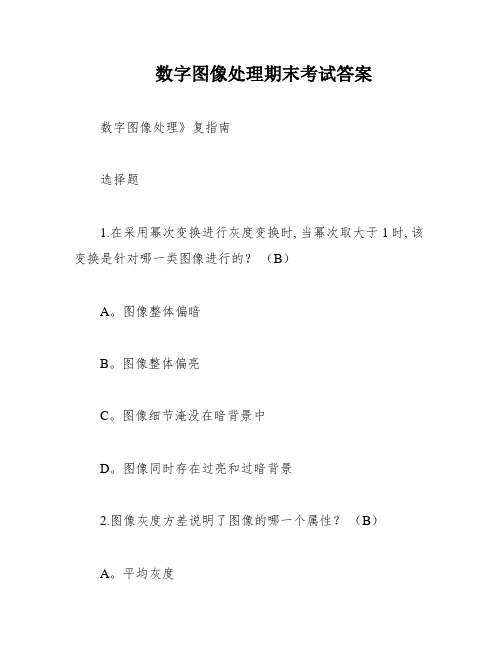
数字图像处理期末考试答案数字图像处理》复指南选择题1.在采用幂次变换进行灰度变换时, 当幂次取大于1时, 该变换是针对哪一类图像进行的?(B)A。
图像整体偏暗B。
图像整体偏亮C。
图像细节淹没在暗背景中D。
图像同时存在过亮和过暗背景2.图像灰度方差说明了图像的哪一个属性?(B)A。
平均灰度B。
图像对比度C。
图像整体亮度D。
图像细节3.计算机显示器主要采用哪一种彩色模型?(A)A。
RGBB。
CMY或CMYKC。
HSI4.采用模板[-11]T主要检测哪个方向的边缘?(A)A。
水平B。
45度C。
垂直D。
135度5.下列算法中属于图像锐化处理的是: (C)A。
低通滤波B。
加权平均法C。
XXX滤波D。
中值滤波6.维纳滤波器通常用于哪种情况?(C)A。
去噪B。
减小图像动态范围C。
复原图像D。
平滑图像7.彩色图像增强时, 可以采用哪种处理方法?(C)A。
直方图均衡化B。
同态滤波C。
加权均值滤波D。
中值滤波8.在对图像进行复原的过程中, B滤波器需要计算哪些功率谱?(B)A。
逆滤波B。
维纳滤波C。
约束最小二乘滤波D。
同态滤波9.XXX滤波后的图像通常较暗, 为改善这种情况, 可以将高通滤波器的转移函数加上一定的常数以引入一些低频分量。
这样的滤波器称为什么?(B)A。
XXX高通滤波器B。
高频提升滤波器C。
高频加强滤波器D。
理想高通滤波器10.图像与灰度直方图之间的对应关系是什么?(B)A。
一一对应B。
多对一C。
一对多D。
都不对应11.下列算法中属于图像锐化处理的是: (C)A。
低通滤波B。
加权平均法C。
XXX滤波D。
中值滤波12.一幅256x256的图像, 若灰度级数为16, 则存储它所需的比特数是多少?(A)A。
256KB。
512KC。
1MD。
2M13.一幅灰度级均匀分布的图像, 其灰度范围在[0, 255], 则该图像的信息量为多少?(D)A。
0B。
255C。
6D。
814.下列算法中属于局部处理的是什么?(D)A。
(完整版)数字图像处理期末考试试题
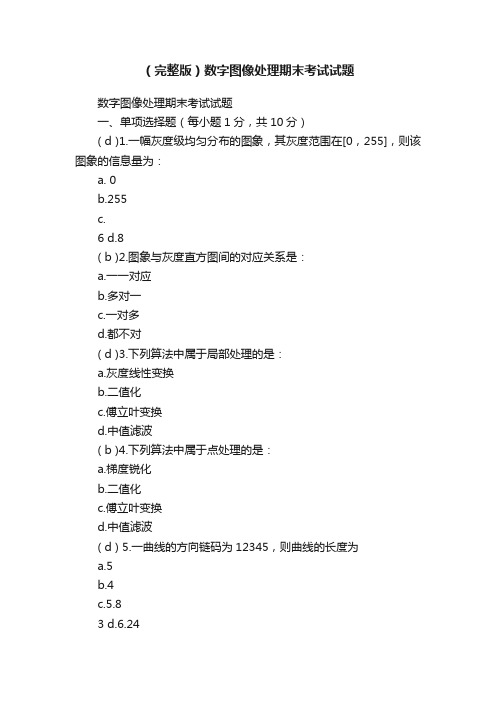
(完整版)数字图像处理期末考试试题数字图像处理期末考试试题一、单项选择题(每小题1分,共10分)( d )1.一幅灰度级均匀分布的图象,其灰度范围在[0,255],则该图象的信息量为:a. 0b.255c.6 d.8( b )2.图象与灰度直方图间的对应关系是:a.一一对应b.多对一c.一对多d.都不对( d )3.下列算法中属于局部处理的是:a.灰度线性变换b.二值化c.傅立叶变换d.中值滤波( b )4.下列算法中属于点处理的是:a.梯度锐化b.二值化c.傅立叶变换d.中值滤波( d ) 5.一曲线的方向链码为12345,则曲线的长度为a.5b.4c.5.83 d.6.24( c )6. 下列算法中属于图象平滑处理的是:a.梯度锐化b.直方图均衡c. 中值滤波/doc/6912669768.html,placia n增强( b )7.下列图象边缘检测算子中抗噪性能最好的是:a.梯度算子b.Prewitt算子c.Roberts算子d. Laplacian算子( c )8.采用模板[-1 1]主要检测____方向的边缘。
a.水平b.45°c.垂直d.135°( d )9.二值图象中分支点的连接数为:a.0b.1c.2 d.3( a )10.对一幅100′100像元的图象,若每像元用8bit表示其灰度值,经霍夫曼编码后压缩图象的数据量为40000bit,则图象的压缩比为:a.2:1b.3:1c.4:1d.1:2二、填空题(每空1分,共15分)1.图像锐化除了在空间域进行外,也可在频率域进行。
2.图像处理中常用的两种邻域是4-邻域和8-邻域。
3.直方图修正法包括直方图均衡和直方图规定化两种方法。
4.常用的灰度内插法有最近邻元法、双线性内插法和(双)三次内插法。
5.多年来建立了许多纹理分析法,这些方法大体可分为统计分析法和结构分析法两大类。
6.低通滤波法是使高频成分受到抑制而让低频成分顺利通过,从而实现图像平滑。
数字图像处理期末复习试题及其答案
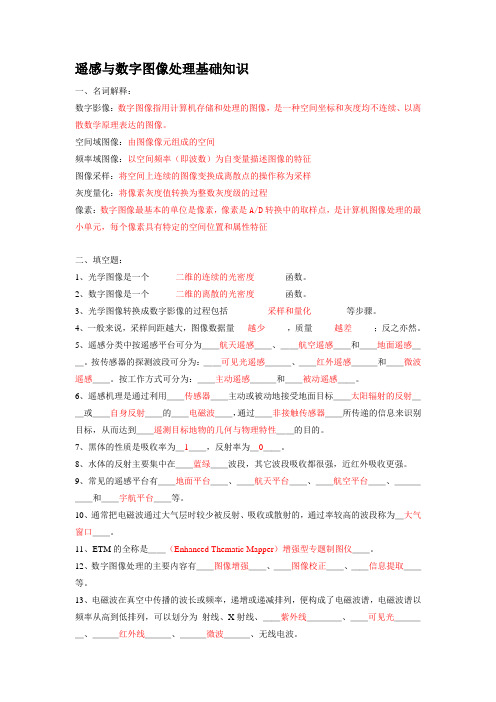
遥感与数字图像处理基础知识一、名词解释:数字影像:数字图像指用计算机存储和处理的图像,是一种空间坐标和灰度均不连续、以离散数学原理表达的图像。
空间域图像:由图像像元组成的空间频率域图像:以空间频率(即波数)为自变量描述图像的特征图像采样:将空间上连续的图像变换成离散点的操作称为采样灰度量化:将像素灰度值转换为整数灰度级的过程像素:数字图像最基本的单位是像素,像素是A/D转换中的取样点,是计算机图像处理的最小单元,每个像素具有特定的空间位置和属性特征二、填空题:1、光学图像是一个_____二维的连续的光密度______ 函数。
2、数字图像是一个_____二维的离散的光密度______ 函数。
3、光学图像转换成数字影像的过程包括________采样和量化_______ 等步骤。
4、一般来说,采样间距越大,图像数据量___越少_____,质量_____越差_____;反之亦然。
5、遥感分类中按遥感平台可分为__航天遥感__、__航空遥感__和__地面遥感__。
按传感器的探测波段可分为:__可见光遥感___、__红外遥感___和__微波遥感__。
按工作方式可分为:__主动遥感___和__被动遥感__。
6、遥感机理是通过利用__传感器__主动或被动地接受地面目标__太阳辐射的反射__或__自身反射__的__电磁波__,通过__非接触传感器__所传递的信息来识别目标,从而达到__遥测目标地物的几何与物理特性__的目的。
7、黑体的性质是吸收率为_1__,反射率为_0__。
8、水体的反射主要集中在__蓝绿__波段,其它波段吸收都很强,近红外吸收更强。
9、常见的遥感平台有__地面平台__、__航天平台__、__航空平台__、_____和__宇航平台__等。
10、通常把电磁波通过大气层时较少被反射、吸收或散射的,通过率较高的波段称为_大气窗口__。
11、ETM的全称是__(Enhanced Thematic Mapper)增强型专题制图仪__。
【数字图像处理】期末复习资料及期末模拟试卷(含答案)doc(DOC)
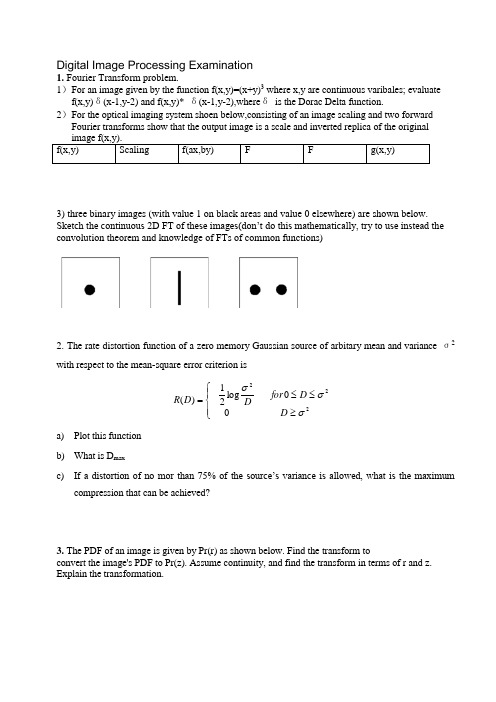
Digital Image Processing Examination1. Fourier Transform problem.1) F or an image given by the function f(x,y)=(x+y)3 where x,y are continuous varibales; evaluatef(x,y)δ(x-1,y-2) and f(x,y)* δ(x-1,y-2),where δ is the Dorac Delta function.2) F or the optical imaging system shoen below,consisting of an image scaling and two forwardFourier transforms show that the output image is a scale and inverted replica of the original image f(x,y). f(x,y) Scaling f(ax,by) F F g(x,y)_3) three binary images (with value 1 on black areas and value 0 elsewhere) are shown below. Sketch the continuous 2D FT of these images(don’t do this mathematically, try to use instead the convolution theorem and knowledge of FTs of common functions)2. The rate distortion function of a zero memory Gaussian source of arbitary mean and variance σ2 with respect to the mean-square error criterion is⎪⎩⎪⎨⎧≥≤≤=22200log 21)(σσσD D for D D Ra) Plot this functionb) What is D maxc) If a distortion of no mor than 75% of the source’s variance is allowed, what is the maximumcompression that can be achieved?3. The PDF of an image is given by Pr(r) as shown below. Find the transform toconvert the image's PDF to Pr(z). Assume continuity, and find the transform in terms of r and z. Explain the transformation.4. A certain inspection application gathers black & white images of parts as they travel along a con-veyor belt. It is necessary to sort the parts into two categories: parts with holes and parts with-out holes. An example of an image that might be taken by the inspection camera is shown at the right. Propose a method to identify and locate the objects of each category in the image so that they can be picked up by a robotic system and placed in different bins. Assume that the imaging system knows where each image pixel is located on the conveyor belt at every point in time.Provide an annotated flow chart of the algorithm you propose.5.In a given application, an averaging mask is applied to input images to reduce noise and then aLaplacian mask is applied to enhance small details. Would mathematics predict that the result should be the same if the order of the operations were reversed? What practical issues would be encountered in computer implementation?Digital Image Processing Examination1. A preprocessing step in an application of microscopy is concerned with the issue ofisolating individual round particles from similar particles that overlap in groups of two or more.Assuming that all particles are of the same size, propose a morphological algorithm that will produce an image that contains only the isolated (non-overlapping) particles that are not in contact with the boundary of the image.2. An image represented by a continuous function f(x, y) is w = 2 cm wide and h = 3 cm high. The imageis to be converted to an array of pixels by a scanner whose response is zero above 80 lines/centimeter in both the horizontal and vertical directions. The discrete image is represented by an array ˆf(n, m) where n and m take on integer values, 0 ~ n ~ N - 1, 0~ m ~ M-1.(a)Determine suitable values for N and M.(b)Assume that ˆf(n, m) = f(na, mb). Determine the values of a and b.(c)Determine constants A, B, C, D, E such that the DFT of fˆ can be expressed as)(00) ,() , (EvmDuniBnCmemnfAvu F+-==∑∑=(d)Find numbers (P1, P2) such that F(u + jP1, v + kP2) = F(u, v) for any integers j, k, u, v.3. The arithmetic decoding process is the reverse of the encoding procedure. Decode the message 0.23355 given the coding model.4. The gradient of a function f (x) is defined as ⎥⎥⎥⎥⎦⎤⎢⎢⎢⎢⎣⎡∂∂∂∂=⎥⎥⎥⎦⎤⎢⎢⎢⎣⎡=∇y f x f G G f y xComputationally, the first derivative is implemented by calculating the difference between adjacent pixels.(a) Is the following a linear operator?2122⎥⎥⎦⎤⎢⎢⎣⎡⎪⎪⎭⎫ ⎝⎛∂∂+⎪⎭⎫ ⎝⎛∂∂=∇y f x f f (b) State how would you implement the above operator using differences between pixels.(c) A Sobel operator uses two masks, Hx and Hy to process an image. Explain why are two masksneeded and what do they measure?(d) Write down the masks Hx and Hy, and identify them in the followingfigures:5. The three images shown were blurred using square averaging masks of sizes n=23, 25 , and 45, respectively. The vertical bars on the left lower part of (a) and (c) are blurred, but a clear separation exists between them. However, the bars have merged in image (b), in spite of the fact that the mask that produced this image is significantly smaller than the mask that produced image (c). explain this.Digital Image Processing Examination1. An image array f(m, n) of size M1 × N1 is to be convolved with a filter array h(m, n) of size M2 × N2 to produce a new image array g(m, n).1)Write a pseudo code program that describes a method to compute g(m, n) throughthe use of Fourier transforms. The result should be the same size as would beachieved with direct convolution.2)Modify the algorithm so that it does the correlation f ~ h rather than theconvolution.2. You have the job of designing an algorithm that will count the number of objects with holes and the number of objects without holes in images of the kind shown here. Assume that the images are binary with 0 corresponding to black and 1 correspondingto white. The imaging system is of low quality and produces images that are corrupted with salt and pepper noise.The objects do not overlap or touch, but may be close to each other in any direction.They may be of any shape or size. The algorithm should not be confused by the salt and pepper noise, and should not count noise pixels as objects.Write a pseudo-code description of your algorithm. You may also include a block diagram and other information to make it understandable to a programmer. State any assumptions you make, such as: “Objects must contain at least 50 pixels.”least 50 pixels.”3. Suppose that an image has the gray-level probability density functions shown. Here, p 1(z) corresponds to objects and p 2(z) corresponds to the background. Assume that p 1=p 2 and find the optimal threshold between object and back ground pixels.4. The Sobel operator computes the following quantity at each location (x, y) in an image array, A:Gx[j,k]=(A[j+1,k+1]+2A[j+1,k]+A[j+1,k-1])-(A[j-1,k+1]+2A[j-1,k]+A[j-1,k-1]) Gy[j,k]=(A[j-1,k-1]+2A[j,k-1]+A[j+1,k-1])-(A[j-1,k+1]+2A[j,k+1]+A[j+1,k+1]) G[j,k] = |Gx[j,k]| + |Gy[j,k]|The position of A[j, k] is column j and row k of the array.The operation is implemented as the convolution of the image array A with two masks, Mx and My followed by the magnitude operation.1) Write a 3 × 3 array for each mask, Mx and My.2) What mathematical operation on an image array is approximated by the Sobeloperator? Show how the Sobel operator is related to the mathematical operation.5. Answer the following questions about morphological image processing.(a) Shown below are two tables with expressions that relate to binary morphological image processing. Associate each expression in the left table with one from the right table.(b) A well-known morphological algorithm uses the following iteration with a structuring element B.(1) Initialize X[p] = 1 for some pixel A p ∈(2) A B X Y )(⊕=(3) If X Y ≠ then set X = Y and repeat (2)An original set A is shown in (A) and an initial pixel p 2 A is shown in (B). The result after one iteration of the algorithm with structuring element⎥⎥⎥⎦⎤⎢⎢⎢⎣⎡=010111010Bis shown in (C). Fill in the result of the next two iterations by marking theappropriate pixels for the set Y in (D) and (E). In frame (F) show the result for Y that would be reached after a large number of iterations.Digital Image Processing Examination1. Consider the edge model depicted below. Sketch the gradient and Laplacian of the signal. It is not needed to compute exact numerical values in your answer. Plot of approximate shapes of the responses will be sufficient.2. The white bars in the test pattern shown are 7pixels wide and 210 pixels high. The separation between bars is 17 pixels. What would this image look like after application of .1) A 3*3 arithmetic mean filter?2) A 7*7 median filter.3) A 9*9 contraharmonic mean filter with Q=13. The video coding system introduced in the class utilizes several major components –inter-frame motion estimation, motion compensated prediction, DCT, Huffman coding,and quantization.(a)When an encoded signal can be used to reconstruct the exact value of theoriginal signal, we say the encoding method is lossless; otherwise, it’s calledlossy. A lossy coding technique introduces distortion to the signal.Which component in the above video coding system is lossy?(b)The motion compensation process in the encoder generates a motion vectorand prediction errors for each image block in the video signal. Suppose duringthe transmission of the encoded video stream, one motion vector is lost (e.g.,due to the network erasure error). What will be the visual effects of suchtransmission errors on the decoded image sequence?4.Consider a black-and-white image consisting of round and rectangular objects, as shown in the image below. Assume the sizes of the objects are fixed and known. We also know that the width and length of the rectangles are larger than the diameter of the circles. None of the rectangles are tilted. In general, the objects may overlap with each other.Design a morphological operation based system to automatically detect all the instances of the rounds objects that overlap with rectangular objects.5. An image A, represented by an N × M array of bytes, has a uniform brightnesshistogram. It is desired transform A into an image B in a way that produces a triangular brightness histogram2550,36240][≤≤=k k MNk h bDescribe a process that will accomplish the transformation. If possible, derive an equation for the transformation function. At a minimum, sketch the transformation function and indicate how you would use it in a program to compute the array B.模拟试卷一1.对将一个像素宽度的8通路转换到4通路提出一种算法。
数字图像处理与机器视觉 2015-2016期末试卷参考答案
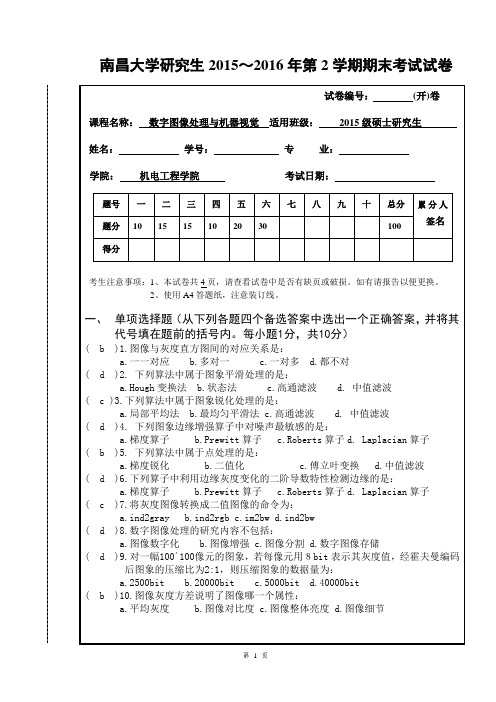
南昌大学研究生2015~2016年第2学期期末考试试卷二、填空题(每空1分,共15分)l. 图像处理中常用的两种邻域是4-邻域和 8-邻域。
2.图象平滑既可在空间域中进行,也可在频率域中进行。
3.常用的灰度内插法有最近邻元法、双线性内插法和三次内插法。
4. 低通滤波法是使高频成分受到抑制而让低频成分顺利通过,从而实现图像平滑。
5.Prewitt边缘检测算子对应的模板是和。
-1-1-1-101000-101111-101(不分先后)6.图像压缩系统是有编码器和解码器两个截然不同的结构块组成的。
7.灰度直方图的纵坐标是该灰度出现的频率。
8.依据图象的保真度,图象编码可分为无失真(无损)编码和有失真(有损)编码两种。
三、名词解释(每小题3分,共15分)1.灰度直方图:2.8-连通的定义:3.中值滤波:4.图像增强:5.直方图均衡化:四、判断改错题(下列说法是否正确,正确的就在题号前的括弧内打“√”,错误的打“×”并改正。
每小题2分,共10分)(√)1.灰度直方图能反映一幅图像各灰度级像元占图像的面积比。
(×)2.中值滤波是一种边缘增强算子。
(×)3.均值滤波器可用于锐化图像边缘。
(×)4.边缘检测属于图象增强。
(×)5.开运算是对原图先进行膨胀处理,后进行腐蚀的处理。
五、简答题(每小题5分,共20分)1.图像锐化滤波的几种方法?2.伪彩色增强和假彩色增强有何异同点?3.简述Laplacian边缘检测算子和边缘增强算子的区别?4.图像增强的目的是什么?六、计算题、编程题(共30分,每小题分标在小题后)1.下列是一幅图像某一行中连续8个像元灰度值,采用1×3窗口对该行分别进行移动平均法和中值滤波法处理,计算输出结果。
(8分)…0,1,0,1,6,6,5,6…答:采用局部(移动)平均法处理,输出的结果为…0,0,0,2,2,6,6,4…(4分)中值滤波法处理,输出结果为…0,0,0,6,6,6,5… (4分)2.对下列信号源符号进行Huffman编码,并计算其冗余度和压缩率。
数字图像处理期末试题参考答案
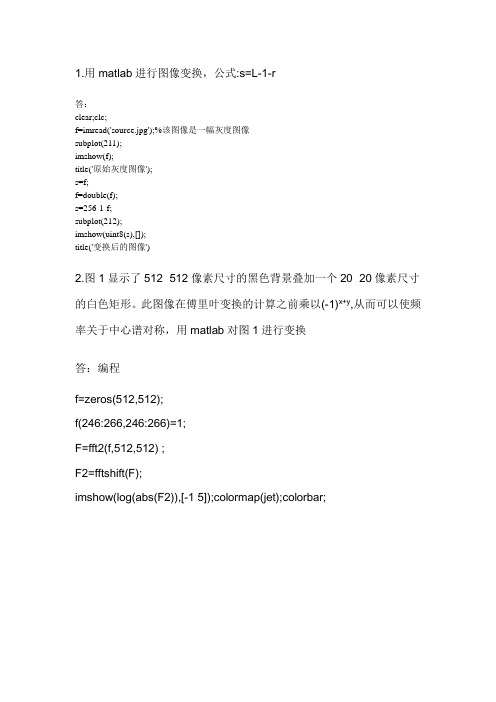
1.用matlab进行图像变换,公式:s=L-1-r答:clear;clc;f=imread('source.jpg');%该图像是一幅灰度图像subplot(211);imshow(f);title('原始灰度图像');s=f;f=double(f);s=256-1-f;subplot(212);imshow(uint8(s),[]);title('变换后的图像')2.图1显示了512×512像素尺寸的黑色背景叠加一个20×20像素尺寸的白色矩形。
此图像在傅里叶变换的计算之前乘以(-1)x+y,从而可以使频率关于中心谱对称,用matlab对图1进行变换答:编程f=zeros(512,512);f(246:266,246:266)=1;F=fft2(f,512,512) ;F2=fftshift(F);imshow(log(abs(F2)),[-1 5]);colormap(jet);colorbar;-0.500.511.522.533.544.53.试给出把灰度范围[0,10]伸长为[0,15],把范围[10,20]伸长为[15,25],并把范围[20,30]压缩为[25,30]的变换方程。
答:由()[]c a y x f ab cd y x g +---=,)(),(得 (1)、3(,)(,)2g x y f x y ⎡⎤=*⎢⎥⎣⎦(2)、5),(),(+=y x f y x g (3)、15),(5.0),(+=y x f y x g4、设一幅图像具有表1所示的概率分布,对其分别进行直方图均衡化和规定化,要求规定化的图像具有表2所示的灰度级分布。
表1表2(1)、直方图均衡化处理结果如下。
- 1、下载文档前请自行甄别文档内容的完整性,平台不提供额外的编辑、内容补充、找答案等附加服务。
- 2、"仅部分预览"的文档,不可在线预览部分如存在完整性等问题,可反馈申请退款(可完整预览的文档不适用该条件!)。
- 3、如文档侵犯您的权益,请联系客服反馈,我们会尽快为您处理(人工客服工作时间:9:00-18:30)。
数字图像处理与机器视觉 2015-2016期末试卷参考答案南昌大学研究生2015,2016年第2学期期末考试试卷
试卷编号: (开)卷课程名称: 数字图像处理与机器视觉适用班级: 2015级硕士研究生姓名: 学号: 专业: 学院: 机电工程学院考试日期: 题号一二三四五六七八九十总分累分人
签名题分 10 15 15 10 20 30 100
得分
考生注意事项:1、本试卷共4页,请查看试卷中是否有缺页或破损。
如有请报告以便更换。
2、使用A4答题纸,注意装订线。
一、单项选择题(从下列各题四个备选答案中选出一个正确答案,并将其
代号填在题前的括号内。
每小题1分,共10分)
( b )1.图像与灰度直方图间的对应关系是:
a.一一对应
b.多对一
c.一对多
d.都不对
( d )2. 下列算法中属于图象平滑处理的是:
a.Hough变换法
b.状态法
c.高通滤波
d. 中值滤波 ( c )3.下列算法中属于图象锐化处理的是:
a.局部平均法
b.最均匀平滑法
c.高通滤波
d. 中值滤波 ( d )4. 下列图象边缘增强算子中对噪声最敏感的是:
a.梯度算子
b.Prewitt算子
c.Roberts算子
d. Laplacian算子 ( b )5. 下列算法中属于点处理的是:
a.梯度锐化
b.二值化
c.傅立叶变换
d.中值滤波 ( d )6.下列算子中利用边缘灰度变化的二阶导数特性检测边缘的是:
a.梯度算子
b.Prewitt算子
c.Roberts算子
d. Laplacian算子 ( c )7.将灰度图像转换成二值图像的命令为:
a.ind2gray
b.ind2rgb
c.im2bw
d.ind2bw
( d )8.数字图像处理的研究内容不包括:
a.图像数字化
b.图像增强
c.图像分割
d.数字图像存储 ( d )9.对一幅100?100像元的图象,若每像元用,bit表示其灰度值,经霍夫曼编码后图象的压缩比为2:1,则压缩图象的数据量为:
a.2500bit
b.20000bit
c.5000bit
d.40000bit
( b )10.图像灰度方差说明了图像哪一个属性:
a.平均灰度
b.图像对比度
c.图像整体亮度
d.图像细节
第 1 页
二、填空题(每空1分,共15分)
l. 图像处理中常用的两种邻域是 4-邻域和 8-邻域。
2.图象平滑既可在空间域中进行,也可在频率域中进行。
3.常用的灰度内插法有最近邻元法、双线性内插法和三次内插法。
4. 低通滤波法是使高频成分受到抑制而让低频成分顺利通过,从而实现图像平滑。
5.Prewitt边缘检测算子对应的模板是和。
-1 -1 -1 -1 0 1
0 0 0 -1 0 1
1 1 1 -1 0 1
(不分先后)
6.图像压缩系统是有编码器和解码器两个截然不同的结构块组成的。
7.灰度直方图的纵坐标是该灰度出现的频率。
8.依据图象的保真度,图象编码可分为无失真(无损)编码和有失真(有损)编码两
种。
三、名词解释(每小题3分,共15分)
1.灰度直方图:
2.8-连通的定义:
3.中值滤波:
4.图像增强:
5.直方图均衡化:
四、判断改错题(下列说法是否正确,正确的就在题号前的括弧内打“?”,
错误的打“×”并改正。
每小题2分,共10分)
(?)1.灰度直方图能反映一幅图像各灰度级像元占图像的面积比。
(×)2.中值滤波是一种边缘增强算子。
(×)3.均值滤波器可用于锐化图像边缘。
(×)4.边缘检测属于图象增强。
(×)5.开运算是对原图先进行膨胀处理,后进行腐蚀的处理。
五、简答题(每小题5分,共20分)
1.图像锐化滤波的几种方法,
2.伪彩色增强和假彩色增强有何异同点,
第 2 页
3.简述Laplacian边缘检测算子和边缘增强算子的区别,
4.图像增强的目的是什么,
六、计算题、编程题(共30分,每小题分标在小题后) 1. 下列是一幅图像某一行中连续8个像元灰度值,采用1×3窗口对该行分别进行移动平均法和中值滤波法处理,计算输出结果。
(8分)
…0,1,0,1,6,6,5,6…
答:
采用局部(移动)平均法处理,输出的结果为
…0,0,0,2,2,6,6,4… (4分)
中值滤波法处理,输出结果为
…0,0,0,6,6,6,5… (4分)
2.对下列信号源符号进行Huffman编码,并计算其冗余度和压缩率。
(12分) 符号 a1 a2 a3 a4 a5 a6 概率 0.1 0.4 0.06 0.1 0.04 0.3
第 3 页
3.在matlab环境中,实现一幅图像的傅里叶变换和傅里叶反变换(将代码作为答案)。
(10)
解:MATLAB程序如下:
A=break(‘rice.tif’);
Imshow(A);
A2=fft(A);
A2=fftshift(A2);
Figure,imshow(log(abs(A2)+1),[0,10]); 第 4 页。
